Perhaps not everyone knows that pork shank, with its centuries-old history, is a dish rooted in ancient times. The first evidence of this delicacy dates back to the Middle Ages, when it was mostly consumed during great feasts and celebrations. Since then, the shank has become an undisputed symbol of pub and traditional restaurant cuisine worldwide, appreciated for its rich flavor and tender, succulent consistency.
But why is the shank so good? Its popularity is due to several factors. First of all, the pork used for the shank is particularly flavorful and, if cooked properly, becomes incredibly tender. Moreover, the shank lends itself to various preparations, from oven cooking to braising, and can be enriched with spices, herbs, and other ingredients that enhance its flavor.
No wonder the shank is a hot seller in pubs and typical restaurants. Its generosity, inviting aroma, and satisfying taste make it the perfect dish to share with friends and family, perhaps accompanied by a good beer or a glass of full-bodied red wine.
However, making an excellent pork shank at home is not always easy. Often, there is a fear that the meat will become tough or that the result will not meet expectations. But today, with this simple and detailed guide, we will learn to prepare the perfect pork shank, as tender and succulent as those from the best restaurants.
Imagine enjoying your homemade pork shank on a cold winter evening, perhaps wrapped in a blanket while it snows outside. The warmth of the oven, the delicious aroma that fills the room, and the satisfaction of having prepared such a tasty dish with your own hands will make this moment even more special.
And if you don’t feel like going out, you can always invite your friends over for dinner and prepare the shank together. It will be an opportunity to share a good bottle of wine, chat, and maybe watch a soccer match or a fun movie.
With this recipe, you’ll no longer have to give up the pleasure of enjoying a great pork shank. You can prepare it whenever you want, for yourself or your loved ones, and impress everyone with your cooking skills.
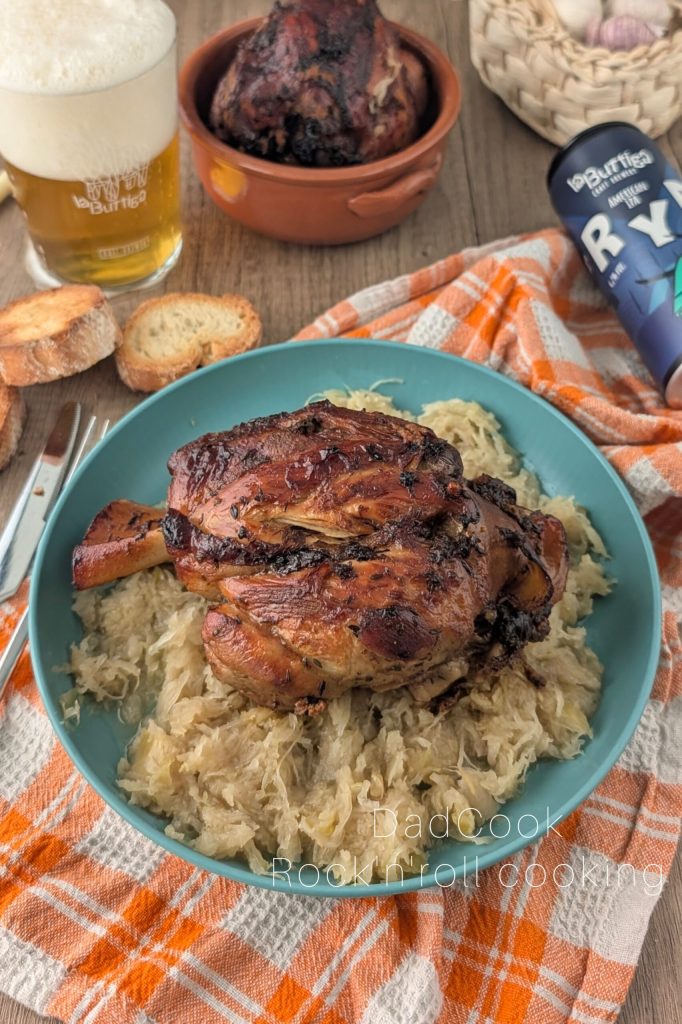
- Difficulty: Very easy
- Cost: Very economical
- Rest time: 1 Day
- Preparation time: 15 Minutes
- Portions: 2
- Cooking methods: Slow Cooking, Stovetop
- Cuisine: Italian
- Seasonality: Autumn, Winter, Autumn, Winter and Spring
Ingredients
- 2 pork shank
- 1 onion
- 2 carrots
- 2 stalks celery
- 2 cloves garlic
- 2 sprigs rosemary
- 1 l beer
- to taste extra virgin olive oil
- 6 berries juniper
- 1 tablespoon cumin seeds
- 2 tablespoons sweet paprika
Tools
hu
- 1 Terracotta pot Fratelli coli
Steps
For cooking my pork shank, I chose to use a terracotta dish.
I chose to do this because terracotta has a unique ability to distribute heat evenly, allowing the shank to cook slowly and uniformly, becoming tender and juicy.
Don’t worry, though! If you don’t have a terracotta dish, don’t fret. A regular oven dish will work just fine.
The important thing is to follow the other steps of the recipe carefully to achieve a perfect result.
The marinade: a flavor bath for the shank.
Take your two pork shanks, weighing around 2.2-2.6 lbs each, and prepare them with an aromatic marinade that will make them even more delicious. In a large enough bowl, pour one liter of IPA beer (India Pale Ale). These beers have an intense and rich flavor, with notes of hops, citrus, and sometimes tropical fruit, which perfectly complements pork.
Now, cut two medium onions into wedges and add them to the beer. Do the same with two celery stalks, cut into pieces. If you don’t have carrots on hand, you can use an extra celery stalk or onion to enrich the marinade. Alternatively, you can add a pinch of chili pepper for a spicy kick.
Add four whole garlic cloves, a sprig of fresh rosemary, dried oregano, 5-6 juniper berries, and a teaspoon of cumin seeds. These ingredients will give the shank an irresistible aroma and a spicy, aromatic flavor. Finally, add a teaspoon of sweet paprika, salt, and black pepper to taste.
Mix all the ingredients in the bowl well, so they blend and marry the flavors. Immerse the shanks in the marinade, making sure they are completely covered by the liquid. Cover the bowl with plastic wrap and place it in the fridge to marinate for at least one whole night.The longer the shank marinates, the more flavor it will gain.

Shank preparation: drying and filtering.
The next day, or after the shank has marinated long enough, take it out of the fridge. Remove it from the marinade and pat it dry carefully with kitchen paper towels.It’s important that the shank is well-dried to facilitate browning in the pan and the subsequent Maillard reaction, which will give the meat that golden color and desired crispy crust.
At this point, filter the marinade liquid with a strainer. This way, you will get a clean liquid, free of spices and vegetables, which you can use for cooking the shank.The vegetables and spices used for marinating can be discarded, as they have already released their flavors into the liquid.

Browning in the pan: a touch of crispiness.
Take a pan large enough to comfortably contain the two shanks. Place it on the stove over medium-high heat and add a drizzle of extra virgin olive oil. When the oil is hot, place the shanks in the pan and let them brown on all sides for a few minutes, until they have a nice golden crust.
Browning is a fundamental step to give the shank flavor and aroma. When the shank cooks, delicious flavors and an irresistible aroma naturally develop. Browning the meat in the pan is the best way to enhance these flavors to the fullest.
Once the shanks are well-browned, add the filtered marinade liquid to the pan. The liquid should reach about halfway up the shanks, without overdoing it.If you prefer, you can add some hot meat broth instead of beer.

Oven cooking: the slow transformation.
Transfer the pan to a preheated oven at 320 degrees Fahrenheit in static mode. Oven cooking is a slow and delicate process that allows the shank to become tender and juicy. Place the pan in the oven and cook the shank for about 4 hours.
After about 4 hours, check the cooking: the meat should have become more tender and should start to detach from the bone. To check the cooking, you can use a fork: if the meat detaches easily from the bone, the shank is ready. If it still seems too tough, continue cooking for another hour, checking occasionally.
During cooking, use a metal ladle to take the liquid from the bottom of the pan and baste the shanks about every hour. This will help keep them moist and distribute the flavors evenly.Be careful not to burn yourself during this operation.
Remember: It is essential that the shank cooks sufficiently to ensure safe cooking and to make the meat tender and juicy.If the shank cooks too quickly, lower the oven temperature to 284 degrees Fahrenheit and continue cooking more slowly.

Rest and serve: time to enjoy.
Once cooked, remove the shanks from the oven and let them rest for 15-20 minutes. Resting is an important step to allow the meat’s juices to redistribute, making it more tender and juicy.After resting, serve one shank per person, accompanied by your favorite side dish. I love shank with sauerkraut, but you can choose roasted potatoes, mashed potatoes, grilled vegetables, or any other side dish you like.
Now, just enjoy this delicious dish, prepared with love and passion. Bon appétit!
Here are some tips for storing pork shank, some ideas for varying the recipe:
Storage
In the refrigerator:
Cooked pork shank can be stored in the refrigerator, in an airtight container, for 3-4 days.
In the freezer:
If you want to store it for longer, you can freeze it. Wrap the shank in plastic wrap and then place it in a food bag. It will keep in the freezer for 2-3 months.
Reheating: To reheat the shank, you can use the microwave, traditional oven, or a pan. If using the oven, I recommend adding a bit of broth or water to prevent the meat from drying out.
Variations
Spices:
You can vary the spices used for marinating and cooking. Try adding, for example, bay leaf, thyme, sage, coriander, or chili pepper.
Vegetables:
You can add other vegetables to the cooking, such as potatoes, mushrooms, cabbage, or squash.
Beer:
You can use a different beer for marinating and cooking. Try an amber beer, a Trappist beer, or a wheat beer.
Sauces:
You can serve the shank with different sauces, such as barbecue sauce, mushroom sauce, green pepper sauce, or fruit mustard.
Sides:
Pork shank pairs perfectly with various sides, such as sauerkraut, roasted potatoes, mashed potatoes, polenta, mixed salad, or grilled vegetables. Additional advice.
Marinade:
For a more effective marinade, you can make shallow cuts on the shank so that the marinade penetrates better.
Cooking:
During cooking, use a steel ladle to take the liquid from the bottom of the pan and baste the shanks about every hour. This will help keep them moist and distribute the flavors evenly.
Service:
Serve the shank hot, accompanied by your favorite side dish and a good beer. I hope these tips and variations are helpful to you!

Pork shank, with its rich flavor and succulent consistency, pairs beautifully with both beer and wine. The choice depends greatly on your personal tastes and the type of preparation. Here are some suggestions:
Dark beers:
Dark beers like stout, porter, or brown ale are an excellent choice. Their intense and toasted flavor pairs well with the richness of the shank.
In particular, I recommend Sophia or Black Shit Monster from the Buttiga brewery in Codogno (PC).
Amber beers: Amber beers, like Belgian ales or Vienna lagers, can also be a good pairing.
IPA: If you’ve used an IPA for marinating or cooking, you can continue with the same type of beer for the pairing. The bitterness of the hops can balance the richness of the shank. In this case, I specifically recommend two beers from the La Buttiga brewery: Ray 3 or Mia Zia.
Wine:
Chianti Classico: A Chianti Classico, with its acidity and tannins, pairs well with the shank, especially if cooked with aromatic herbs.
Syrah: A Syrah, with its spicy and fruity notes, can be an excellent choice.
Cabernet Sauvignon: A robust and intense Cabernet Sauvignon can be a suitable pairing, especially if the shank is cooked with a rich sauce.
Other red wines:
A Merlot, Sangiovese, or Pinot Noir can also be suitable, depending on the specific characteristics of the dish.
Additional tips:
Consider the side dish: If you’ve served the shank with a particular side dish, like sauerkraut or roasted potatoes, choose the beverage that pairs best with the overall dish.
Serving temperature:
Both beer and wine should be served at the correct temperature to enhance their flavors.
Experiment:
Don’t be afraid to experiment and try different combinations to find the one you like best.
I hope these suggestions are useful to you! Cheers 🍻
FAQ (Frequently Asked Questions)
Here are some frequently asked questions about pork shank.
What is pork shank?
It is the part of the pig’s leg located between the knee and the hoof. It is a flavorful and versatile cut of meat that can be cooked in various ways.

How to cook pork shank?
There are different cooking techniques, including baking, braising, stewing, and grilling. The choice depends on the desired result and the time available.
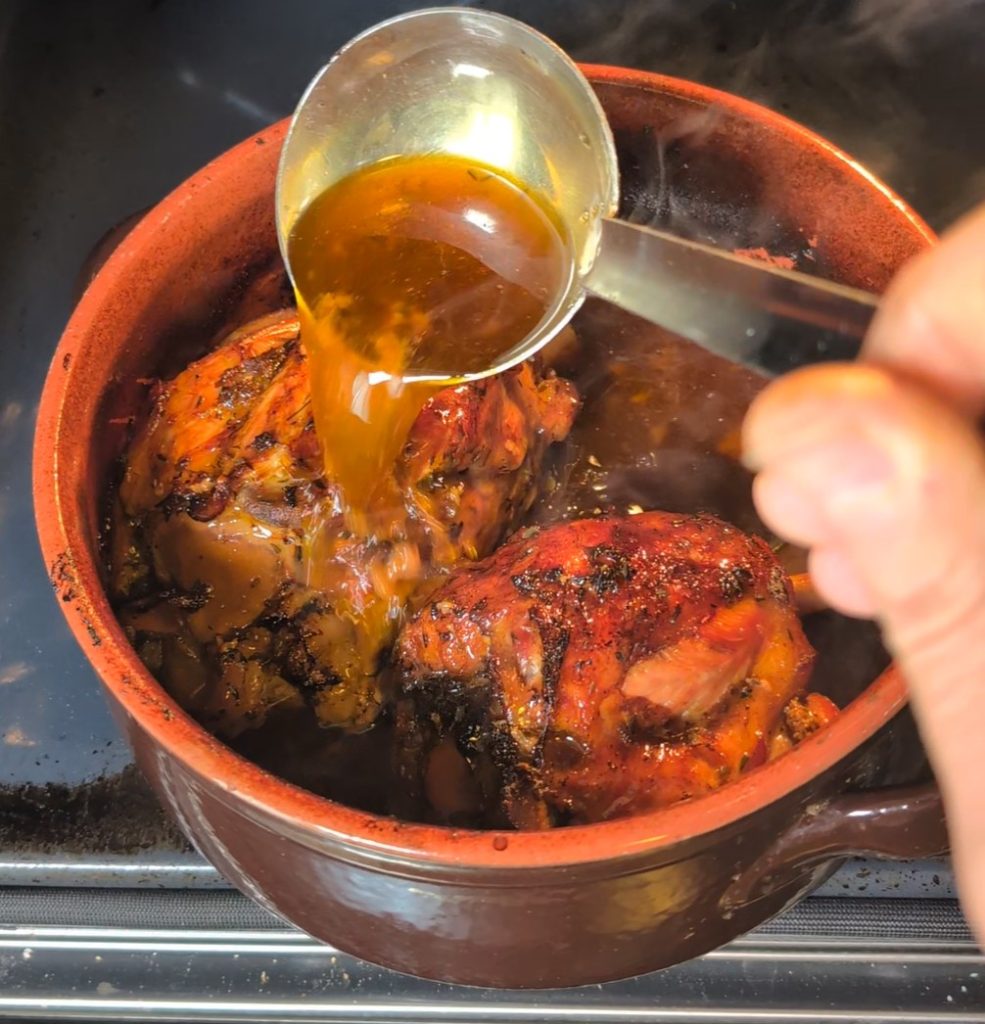
What are the ingredients for oven-baked pork shank?
The ingredients vary depending on the recipe, but generally, pork meat, vegetables (onions, carrots, celery), herbs (garlic, rosemary, bay leaf, juniper), beer or wine, salt, pepper, and extra virgin olive oil are used.
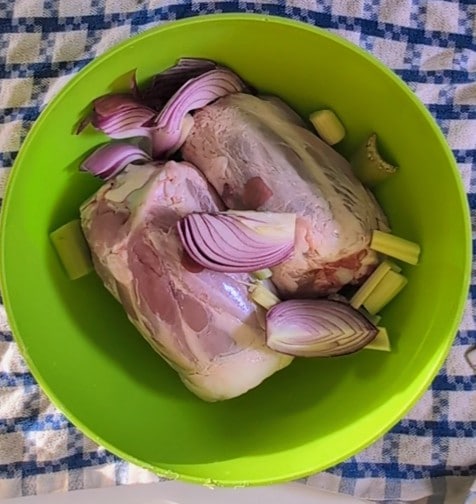
How to marinate pork shank?
Marinating is an important step to flavor the meat and make it more tender. You can use beer, wine, aromatic herbs, spices, and other ingredients.
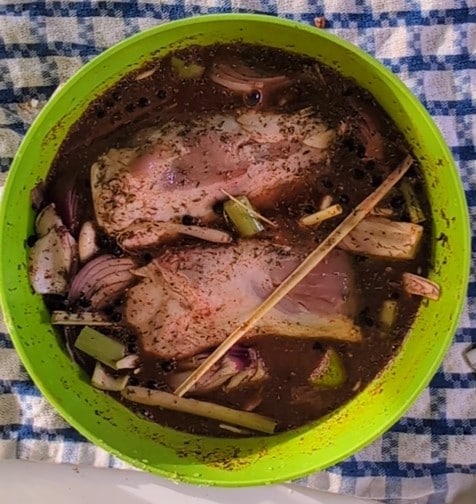
How long does pork shank cook?
Cooking times vary based on the weight of the shank and the chosen cooking method. Generally, oven cooking requires several hours.
How to know if the shank is cooked? The meat should be tender and easily detach from the bone. You can also use a kitchen thermometer to check the internal temperature, which should reach 185-194 degrees Fahrenheit.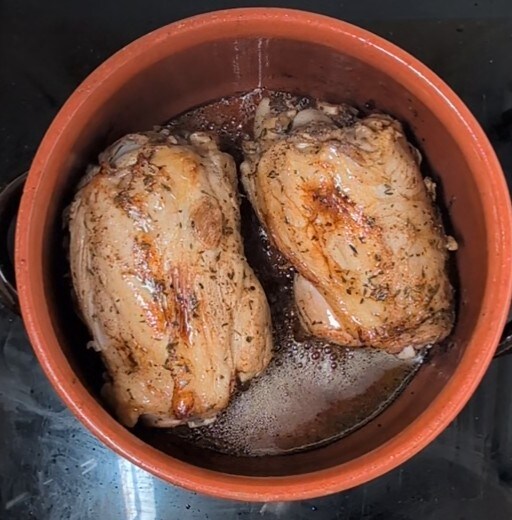
How to serve pork shank?
Pork shank pairs perfectly with various sides, such as sauerkraut, roasted potatoes, mashed potatoes, polenta, or grilled vegetables.

What are those sprigs you put in the marinade?
They are lemongrass, an aromatic plant with a fresh, lemony scent. I added it to give an extra aromatic touch to the marinade and to balance the rich flavor of the pork shank.
If you can’t find it, you can use grated lemon zest or fresh ginger.

